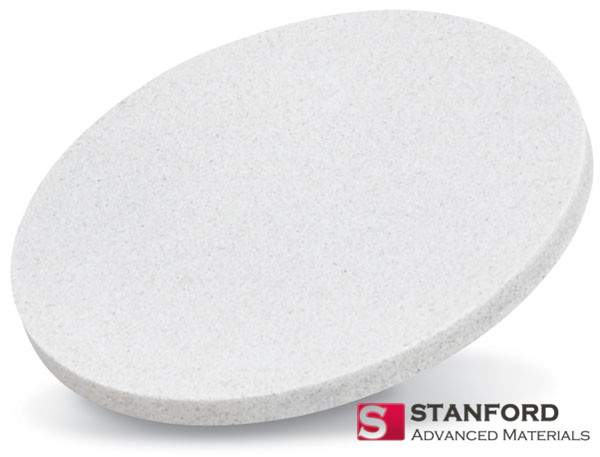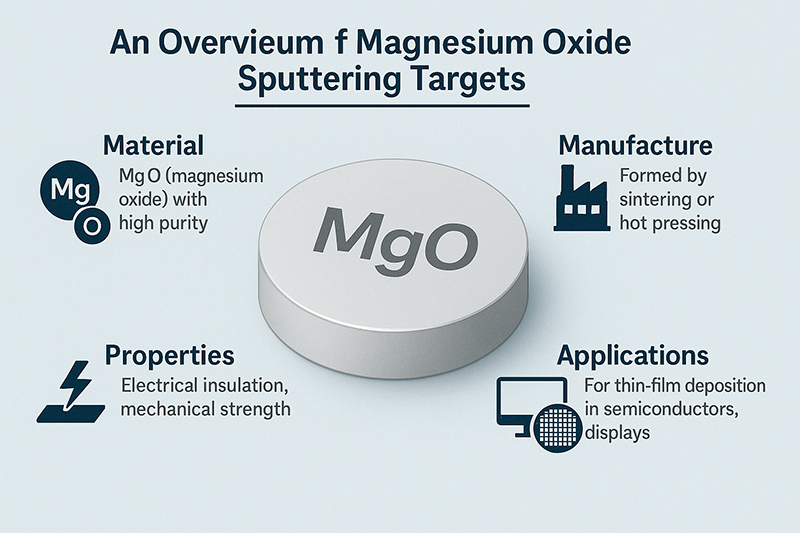What is a Magnesium Oxide Sputtering Target?
A Magnesium Oxide sputtering target is a solid, high-purity ceramic disc or plate used in a physical vapor deposition (PVD) technique called sputtering. The target, in vacuum conditions within a vacuum chamber, is bombarded by high-energy ions (typically of an inert gas like argon), and MgO atoms are ejected from its surface. These atoms diffuse and accumulate on a substrate (like a silicon wafer) to leave a thin, uniform coating.
The purity of this end-product depends directly on the quality of the target. MgO targets are not simply compressed powder; they are engineered ceramics, manufactured to high standards of purity, density, and structural integrity to withstand the demanding conditions of the sputtering process and deliver consistent, repeatable performance.
Key Properties of MaO Sputtering Targets
Performance of MgO targets is marked by inherent magnesium oxide material properties, appreciated for stability and insulating properties.
Fundamental Properties:
- Chemical Formula: MgO
- Crystal Structure: Cubic (Rock Salt)
- Molecular Weight: 40.304 g/mol
Physical & Thermal Properties:
- High Melting Point: ~2852°C. This offers excellent thermal stability, which deters target degradation at high-power sputtering.
- Density: ~3.58 g/cm³. High theoretical density is crucial in delivering dense, high-quality films with minimal defects.
- Mechanical Strength: MgO is a brittle, hard ceramic. Targets are engineered to achieve maximum mechanical strength in order to prevent cracking upon handling and usage.
Electrical & Chemical Properties:
- Good Electrical Insulator: This is an essential characteristic. MgO films are very good dielectric layers, insulating against current passage but enabling an electrostatic field to be present.
- High Chemical Stability: MgO is highly corrosion and oxidation resistant, with stability of the deposited film ensured even in harsh environments.
- High Purity (typically 99.9% – 99.99%): Required to prevent contamination that would disable the operation of sensitive devices like semiconductors.

Manufacturing Process
The production of high-performance MgO targets is a meticulous multi-step process:
- Manufacturing high-performance MgO targets is a meticulous multi-step process:
- Powder Synthesis & Purification: It begins with high-purity Magnesium Oxide powder, typically synthesized to fulfill the needed chemical and physical properties.
- Pressing: The powder is compressed under high pressure (e.g., cold isostatic pressing) into a “green body” of initial target shape.
- Sintering: This is the critical step. The pressed compact is heated to extremely high temperatures below the melting point. This fuses the powder particles into a solid, dense, and mechanically robust ceramic body.
- Machining & Finishing: The target sintered is precision-machined to meet strict dimensional tolerances. Surface is then carefully polished to a specified roughness to enable sputter erosion and defect-free deposition of films.
- Quality Control: Each target undergoes rigorous testing, such as dimension checking, purity analysis, and microstructural analysis to ensure it meets all specifications.
Critical Applications: Where MgO Targets Make a Difference
Magnetic Random-Access Memory (MRAM)
It is one of the most significant applications. An ultra-thin MgO layer (just nanometers thick) is applied as the tunnel barrier in MRAM cells. The purity of the MgO layer determines directly the efficiency, speed, and retention of the data by the device, and it thus becomes the backbone of future, non-volatile memory.
Semiconductor & Display Fabrication
Gate Insulators: Used as a high-κ dielectric layer in thin-film transistors (TFTs) of next-generation displays and logic chips.
Protective Passivation Layers: MgO films are applied to protect semiconductor devices from moisture, ions, and electric leakage.
Protective & Optical Coatings
Thermal Barrier Coatings (TBCs): Applied to turbine blades and high-temperature components in aerospace and energy sectors.
Optical Coatings: Used in lasers and infrared windows due to its transparency in certain wavelengths and environmental stability.
Solid-State Batteries
As a research field, MgO is investigated as a protective coating or solid electrolyte component in an attempt to enhance battery safety and cycle life.
Comparison with Other Sputtering Target Materials
It is more appropriate to compare MgO with other ceramic targets rather than conductive metals:
MgO vs. Aluminum Oxide (Al₂O₃): MgO usually has a higher dielectric constant and enhanced alkali ion migration resistance, hence more suitable for specific semiconductor applications.
MgO vs. Silicon Dioxide (SiO₂): MgO has superior thermal stability and higher dielectric constant, but at the cost of cost and some integration limitations.
Conclusion: MgO targets are the material of choice for those applications that need superior insulating characteristics, better thermal stability, and ultimate reliability in high-end electronic and optical devices.
Conclusion
Magnesium Oxide sputtering targets are more than just a source material; they are an enabling technology for the devices that power our digital economy. From enabling the storage of high-density data in MRAM through to the reliability of future semiconductors, the value of a high-quality MgO target cannot be overstated.
At Stanford Advanced Materials (SAM), our specialty is to provide high-purity, dense Magnesium Oxide sputtering targets that are specifically formulated to meet the high standards of your R&D and manufacturing processes. Through our advanced ceramics experience, you can have a product that delivers consistently, batch to batch.
Want to enhance your thin-film application? Contact SAM today to talk about your individual MgO target requirements and request a quote.





